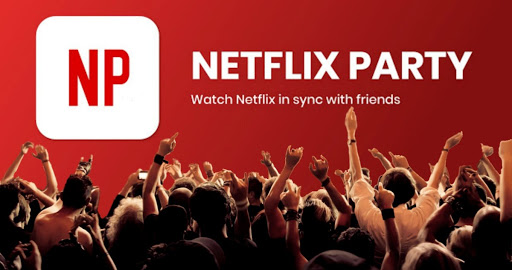TV Party Tonight? Co-watching Catches Fire
Watching TV with other people, whether they're in the same room or not, Is suddenly a hot trend as viewers settle in for the long, cold pandemic winter

In a time of isolation that’s driving online video streaming skyward, it’s no surprise that one of the hottest new features is co-viewing: watching a show together, even when you’re alone.
Co-viewing can be a capacious term in the TV world. It includes that old-fashioned notion of a family gathering ‘round the electronic hearth, like a broadcast executive’s nostalgia dream of 1973. Amid the strictures of the pandemic, that kind of co-viewing has jumped notably this year, according to a Nielsen study done in the spring.
Streaming video has been particularly popular for that kind of same-room co-viewing, given the flexibility it provides in finding a mutually acceptable show to watch together, Nielsen found. Nearly half of those on a streaming device are watching with someone else, while only about a third of those on linear TV are doing so. And co-viewing on streaming TV jumped 15% in March, the first month of the pandemic.
Executives at WildBrain Spark, the digital arm of the British children’s programming company, said they’ve seen a big jump in families gathering, especially in the evening, around connected TVs and those with OTT devices to watch their shows. Particularly notable is how much of that viewing is done of their broadcast-length shows on YouTube.
That vast video repertory, the second-most-watched on CTV according to Comscore, isn’t often thought of as a go-to spot for longer shows. But WildBrain’s programming library includes notable brands such as The Smurfs, Teletubbies, Peanuts, Moomin, and Inspector Gadget. There’s plenty of name-brand stuff for locked-down families to pick through.
WildBrain Spark GM Jon Gisby said last month that with cooler weather coming and fewer entertainment alternatives available, the company expects even more growth in that viewing pattern: long-form shows, on big screens, even from platforms such as YouTube.
For all the return to the digital hearth, however, not everyone’s able to share a show with those they love in person.
The smarter way to stay on top of the streaming and OTT industry. Sign up below.
We’re also seeing a flurry of efforts, both by the big streaming services and smaller third-party companies, to provide more connectivity in a disconnected time.
Disney Plus, for instance, just joined the ranks of major subscription VOD services with a built-in remote co-watching for its customers. GroupWatch launched in the United States in late September after trials in Australia, New Zealand and Canada.
Also read: Disney Plus Launches GroupWatch Feature
The function works through the app on any device or the web, but doesn’t include video chat capabilities, a substantial omission for some people trying to both watch a show together, and watch each other doing it.
With the launch, Disney Plus joins several competitors in offering some version of remote co-viewing. This summer, Amazon Prime Video added co-viewing. And Disney-owned Hulu previously added the capability.
Third-party providers are also trying to meet the opportunity.
Netflix Party, a Chrome browser extension, allows subscribers to watch the streaming king together, wherever they are. But because it’s a browser extension, there are limits: you need to be on a device that can run Google Chrome, which cuts out a lot of potential co-viewing opportunities.
One of the most ambitious third-party efforts comes from Scener, a two-year-old Seattle startup that got its start in the LAUNCH incubator backed by O.G. streaming-video technology company RealNetworks.
Scener already has deals to enable co-viewing of shows on 10 big streaming services, including Netflix, Hulu, Disney Plus, HBO Max, Amazon Prime Video, YouTube, Vimeo, Disney-owned Indian service Hotstar and Sony-owned Funimation. It also provides video chat for users across all those services, allowing for a much more immersive experience.
Last week, Scener announced a $2.1 million seed round of funding, including an investment from the investment company of RealNetworks founder Rob Glaser, to help expand the service, especially for a new set of B2B customers, said COO Joe Braidwood.
During the pandemic, the company found its service being pressed into duty by big live events that formally were held in person, such as San Diego Comic-Con and Fantastic Fest, the genre film festival from the Texas-based Alamo Drafthouse theater chain.
Those bespoke live events—serving thousands or tens of thousands of simultaneous viewers with panels, screenings, trailers and video chat—have forced Scener to iterate quickly on its capabilities, and to provide a little more nuance and control, Braidwood said.
With Fantastic Fest, for instance, they quickly found that many fans didn’t want video chat going during a big premiere. But for the midnight showing of a compilation of slasher-film highlights, with commentary between each scene from an Alamo Drafthouse programmer, the video chat very much was essential to the experience.
“It’s a very genre-specific type of problem,” Braidwood said. The slasher highlights are the kind of online project that should feature “interactive content where you’re supposed to scream out and share.”
Scener will devote some of its new resources to build out live-event functions like the ability to dial up a profanity filter for more family-oriented programming, and a ticketing function that can charge a few dollars for events. That latter is a way to quickly separate true fans from drop-in troublemakers, Braidwood said.
“We’re just beginning to explore what the B2B aspects of this look like,” Scener COO Joe Braidwood said. “We’re prioritizing what we do next. It’s a very interesting niche business model.”
Another business partner for Scener is RiffTrax, which was founded 14 years ago by the mischievous makers of the long-running Mystery Science Theater 3000 TV series,
RiffTrax sells comedic commentaries that are overlaid, MST3K style, on top of a wide range of trashy genre films. The company’s makers quickly glommed onto Scener’s possibilities for their business, so much so that the company and its CEO David G. Martin both joined the funding round.
“We’ve been waiting our entire 14 years for this ‘perfect sync’ technology to exist in a watch-party environment and Scener is the first we’ve seen to achieve it,” said Martin. “We look forward to future RiffTrax Live events with over 100,000 people simultaneously watching and laughing along with a movie together on Scener.”
David Bloom of Words & Deeds Media is a Santa Monica, Calif.-based writer, podcaster, and consultant focused on the transformative collision of technology, media and entertainment. Bloom is a senior contributor to numerous publications, and producer/host of the Bloom in Tech podcast. He has taught digital media at USC School of Cinematic Arts, and guest lectures regularly at numerous other universities. Bloom formerly worked for Variety, Deadline, Red Herring, and the Los Angeles Daily News, among other publications; was VP of corporate communications at MGM; and was associate dean and chief communications officer at the USC Marshall School of Business. Bloom graduated with honors from the University of Missouri School of Journalism.

